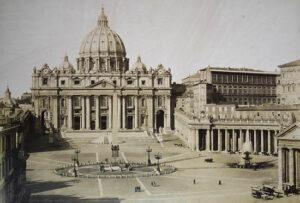HISTORY OF THE VATICAN CITY STATE

The actual Vatican City State was established by virtue of the Lateran Treaty of 11th February 1929 between the Holy See and Italy. The Vatican City State has the essential and exclusive purpose of providing the Holy See with the territory necessary to guarantee its absolute independence and liberty for its lofty spiritual mission in the world.
The Holy See possesses a sovereignty distinct from the territorial sovereignty of the Vatican City State: the Holy See represents the Catholic Church throughout the world. As a sovereign entity, it has long enjoyed the right of active and passive legation: it sends out representatives and receives those of States. These diplomatic relations have considerably developed in recent years. At present, the Holy See entertains Diplomatic Relationships with almost 200 Countries and since Holy See is also sensitive to problems of justice, peace, disarmament, international security, and development, as well as to the social, cultural, and scientific problems of the modern world, it has representatives in the various international organizations too.
The main monument in the Vatican is St. Peter’s Church, the biggest in the world. It was built in the Vatican Circus, where many Christians suffered martyrdom in the first two centuries: among them was the Apostle Peter who is buried there. The tomb has been venerated by Christians since the first century.
The place was leveled after 320, in the time of the Roman Emperor Constantine. The first church in honor of Saint Peter built in the fourth century was restored in 1452. Its demolition began in 1506; the construction of a new church was begun on the foundation of the first one and was completed in 1626. The present church of Saint Peter has an area of 15,160 square meters and an internal length of 186 meters.
